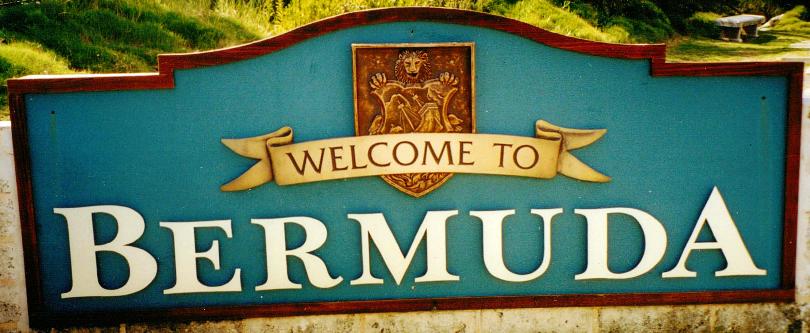
Click on graphic above to navigate the 165+ web files on this website, a regularly updated Gazetteer, an in-depth description of our island's internally self-governing British Overseas Territory 900 miles north of the Caribbean, 600 miles east of North Carolina, USA. With accommodation options, airlines, airport, actors, actresses, aviation, banks, beaches, Bermuda Dollar, Bermuda Government, Bermuda-incorporated businesses and companies including insurers and reinsurers, Bermudians, books and publications, bridges and causeway, charities, churches, citizenship by Status, City of Hamilton, commerce, communities, credit cards, cruise ships, cuisine, currency, disability accessibility, Devonshire Parish, districts, Dockyard, economy, education, employers, employment, environment, executorships, fauna, ferries, flora, former military bases, forts, gardens, geography, getting around, golf, guest houses, highways, history, historic properties, Hamilton, House of Assembly, housing, hotels, immigration, import duties, internet access, islands, laws, legal system and legislators, main roads, marriages, media, members of parliament, money, motor vehicles, municipalities, music and musicians, newcomers, newspaper, media, organizations, parks, parishes, Paget, Pembroke, performing artists, residents, pensions, political parties, postage stamps, public holidays, public transportation, railway trail, real estate, registries of aircraft and ships, religions, Royal Naval Dockyard, Sandys, senior citizens, Smith's, Somerset Village, Southampton, St. David's Island, St George's, Spanish Point, Spittal Pond, sports, taxes, telecommunications, time zone, traditions, tourism, Town of St. George, Tucker's Town, utilities, water sports, Warwick, weather, wildlife, work permits.
![]()
By Editor/Author Keith Archibald Forbes (see About Us).
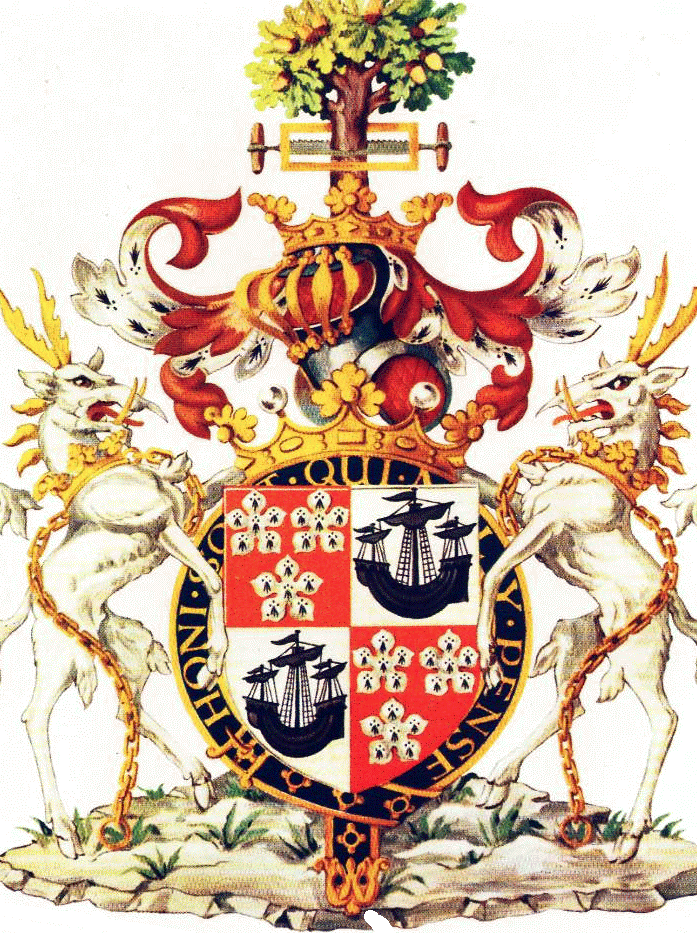
Part of Hamilton Parish's crest, from that of the 2nd Marquis of Hamilton. His coat of arms, copyrighted by his family, members of which still exist today, is exactly what is shown on Bermuda's Hamilton Parish crest. Used with exclusive permission from the copyright owners. Do not copy.
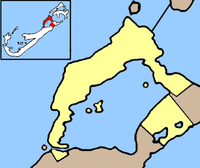 Book: Bermuda's Architectural Heritage: Hamilton
Parish. Diana Chudleigh. 2002, Bermuda National Trust. 4th in
its historic buildings book series. 230 pages. Illustrated with B&W
photographs. $29.95.
Book: Bermuda's Architectural Heritage: Hamilton
Parish. Diana Chudleigh. 2002, Bermuda National Trust. 4th in
its historic buildings book series. 230 pages. Illustrated with B&W
photographs. $29.95.
Hamilton Parish was not the original name. It was Harrington Tribe, after and a slight misspelling of Lucy (nee Russell) Harington, or Harrington.. She was born in 1580, the daughter of Sir John Harington of Exton and died in 1627. She spoke French, Italian and Spanish. On December 12, 1594, at the age of nearly 14, she married Edward Russell, 3rd Earl of Bedford, then 22. She was a wealthy and influential woman, a major aristocratic patron of the arts and literature in the Elizabethan and Jacobean eras. Some have referred to her as the universal patron of poets. (Part of the Parish and a local Government run school have Harrington in their name. (Another historical narrative shows, wrongly, a point that has never been corrected, that this parish was once called Bedford Tribe, after the Duke of Bedford, her husband. It was never called that).
After the financial misfortunes of herself and her husband came another wealthy aristocratic patron, James Hamilton (1589-1625), 2nd Marquis of Hamilton in the Scottish peerage. He bought out Lucy Harington's interests. The Scottish town of Hamilton, not far from Glasgow, was named after his family's extensive land holdings He was one of the many Scots peers who accompanied King James VI of Scotland and first of England to London when he ascended the throne on the death of Queen Elizabeth 1 in 1603. He was one of the gentlemen Adventurers who invested in the Bermuda Company to colonize it from 1615. As he was the largest shareholder in the original Hamilton Tribe, it took his name and the parish bears his coat of arms of the time. Loyal Hamilton was once proposed as a husband for the King's daughter. In 1620, he became a member of the Council for the Plantations of New England and later was rewarded as a Knight of the Garter. He died of a malignant fever in 1625 and his death is said to have hastened that of his Royal friend.
His son and heir was executed for treason in 1649, his title reverted to his brother William and on his death in 1651, to his eldest surviving daughter Anne, Duchess of Hamilton in her own right.
British Governor William Hamilton, after whom Bermuda's City of Hamilton eight miles away from this parish is named, was related to this Scottish House of Hamilton. There is still a Duke of Hamilton.
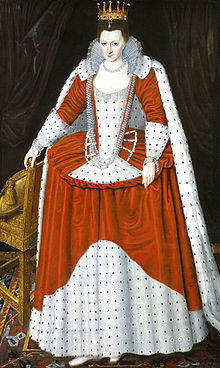

Lucy Harington and James, 2nd Marquis of Hamilton
Early settlers called the Parish or Tribe Bailey's Bay. In 1623, adventurer Captain John Smith, famous in American, Bermudian and British history, encountered many spooky caves in this Parish. It is unrelated to the City of Hamilton eight miles away. It is Bermuda's second most eastern Parish, on the North and South Shores. It has deep water limestone caves, with subterranean passages. They have stalactites and stalagmites of Gothic grandeur. They began during the Pleistocene Ice Age. Sites include the Crystal Caves and the Grotto Bay Hotel's Cathedral and Prospero's Caves.
Altogether, there are 10 accessible caves in Bermuda that have sea water pools with a maximum depth of 80 feet given tidal variations. Most are in this Parish
![]()
![]()
Visitors are asked to respect private property and not to disturb agricultural land. Visiting the cliff face is discouraged, both to protect rare plant life, and because the terrain is steep and the footing is loose. Poison Ivy is common on Abbot's Cliff and along the edges of the footpath.
The site was added to the Bermuda National Parks & Nature Reserves system in the latter part of the year 2000. Abbott is an old Bermudian family name. The park is in two separate areas of land, one of 5.61 hectares (13.86 acres) and the other of 1.77 hectares (4.36 acres), for a total area of 7.38 hectares or 18.22 acres The cliff is reputed to be all that remains of a huge prehistoric cavern. There is a sheer wall of limestone between My Lord's Bay and Church Bay. It includes Abbott's Cliff Road and Abbott's Crescent. The park has splendid walking along unmarked trails and lovely frequent views of Harrington Sound and its islands. Most visitors are unaware of the scenic beauty of Bermuda as it once was on this walk and the great variety of plants they can see. The site remains an important refuge for rare native and endemic plants that have disappeared from other parts of Bermuda. Rare species found here include the Toothed Spleenwort, Bermuda Bedstraw, Snowberry and Wild Bermuda Pepper.
![]()
![]()
40 North Shore Road, Flatts FL 04. Phone (441) 293-2727. A major Bermuda attraction, suitable for all the family. Next to Flatts Bridge, where the Atlantic Ocean flows into First Flatts Inlet and then the inland Harrington Sound lake. It dates back to the first decade of the 20th century when scientists from distinguished American universities set up a summer camp to carry out oceanographic research at Bermuda. A local sister organization known as the Bermuda Natural History Society, established in 1901, provided a year-round aquarium for the scientists. It began at Agar's Island (see Bermuda Islands) and moved from Agar's Island to its present location in 1926 when the two groups split.
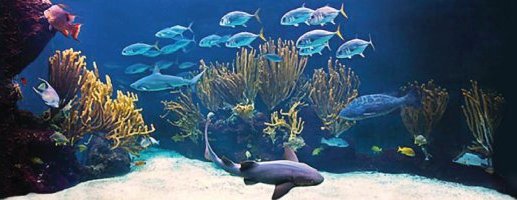
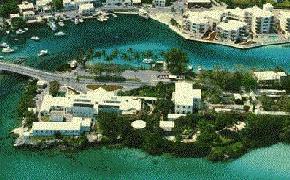
Today, The Aquarium, Museum and Zoo has fascinating displays of animal, aquatic and marine life and natural history. The Aquarium alone, pictured above, is superb. You could easily spend the best part of a day here, whether you arrive by air or cruise ship. An admission fee applies.
Bermuda sea shells. The largest and most complete collection of Bermuda shells to be found anywhere in the world was donated in October 2001 to this facility. They were collected by retired Bermuda banker Jack Lightbourn and his late colleague and friend Arthur Guest since 1965. There are about 7,700 species in all.
![]()
This parish is part of it, as the website above shows.
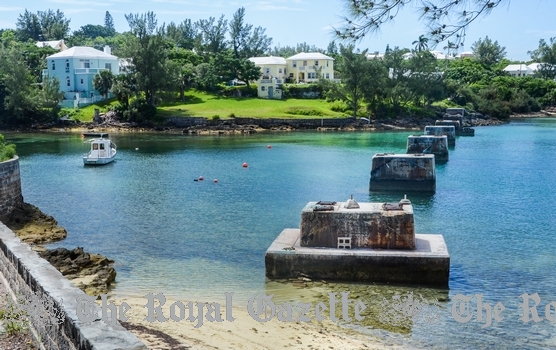
The Bermuda Railway once passed over these remnants of a Bailey's Bay, Hamilton Parish, bridge
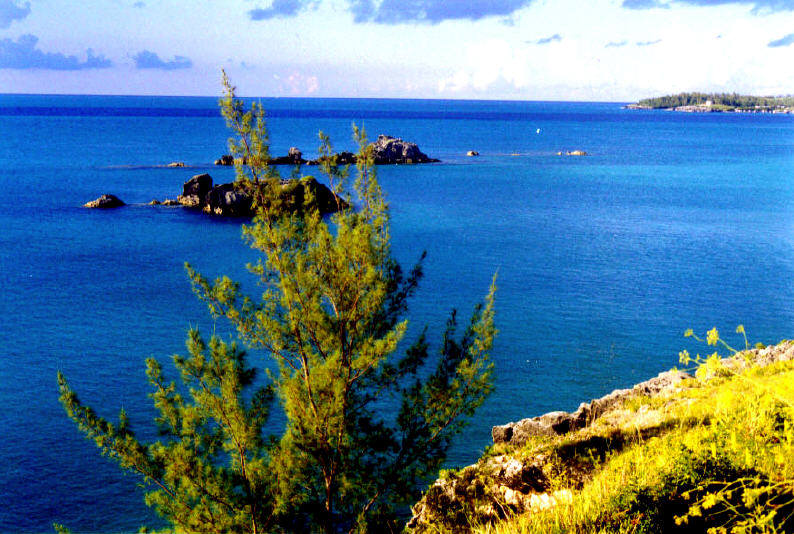
One of the magnificent views from the Hamilton Parish part of the Railway Trail. Photo by author Keith A. Forbes, solely for Bermuda Online
![]()
Follow the coastline to your right. See caves with their access almost completely hidden. Some have deep water pools. Further south, the park merges with the large Walsingham Trust property (private, locally owned, but free entry, known as the Walsingham Nature Reserve, the center of which is Tom Moore's Tavern in that part of the Reserve known as Tom Moore's Jungle. It connects to Blue Hole Park through a woodland trail leading under bush archways.
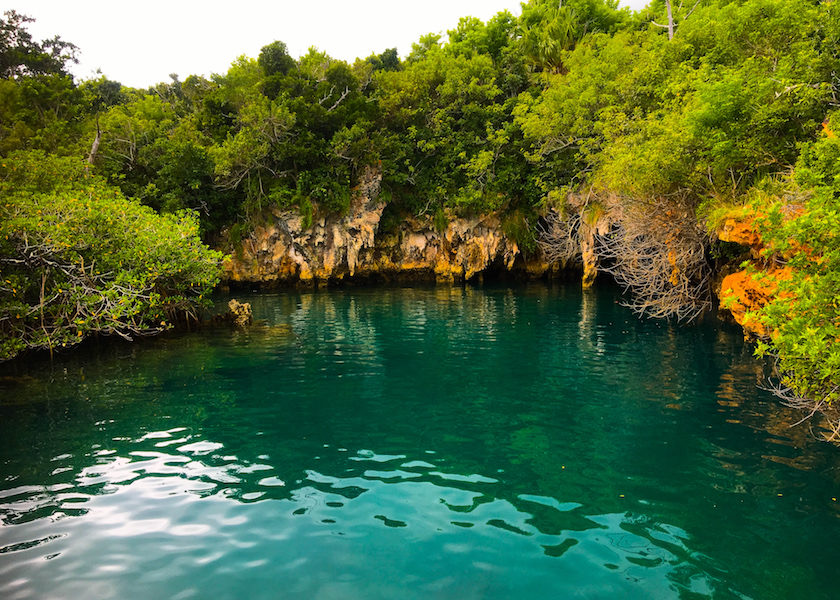
The latter, not really a jungle, more of a large and largely-untamed property (open sunrise to sunset daily, admission free), is technically owned by a private family trust but is open to the public. It encompasses coast and forested land from Blue Hole Park to Tom Moore’s Jungle (as Walsingham Nature Reserve is more frequently called).
![]()
![]()
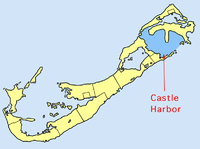 This exquisite large harbor is one
of Bermuda's maritime gems. See it from an excursion boat from the Grotto Bay Hotel. It is the magnificent waterfront and beach areas for much of
both this Hamilton Parish and St.
George's Parish. At one time, until the waters silted up too much, it was where the Royal
Navy moored its vessels in Bermuda waters. A resident Admiral had his residence
overlooking the harbor. There are many islands and beach areas. Castle Harbour has had a
once-brilliant, then-somewhat sad hotel history. The first hotel here, which lasted
until the 1990s, was the exquisite old Castle Harbour Hotel, then one of the
finest in the world. It was built in 1931 by the British shipping company Furness Withy,
which from the 1920s until the 1950s had extensive business interests in Bermuda
including this original hotel, also the Belmont Manor Hotel in Warwick Parish
and two beautiful cruise ships the Queen of Bermuda and Ocean Monarch, both of
which served Bermuda for generations until the late 1960s. But the
original hotel development came
at a huge cost to the environment. Before construction started in the 1930s,
magnificent Church Cave and Bitumen Cave were at the entrance of the
development. Church Cave was noted for having one of the largest underground
lakes in Bermuda. During much World War 2, the
Castle Harbour Hotel was closed to guests. When American troops were billeted in
Bermuda, many stayed at the hotel until their US Army Air Force Base on St.
David's Island a few miles away was built by American taxpayers. Some time after World War 2, Bermuda Properties Limited - which still owns
the site - bought it from Furness Withy. But it continued as the Castle Harbour
Hotel for many years afterwards.
This exquisite large harbor is one
of Bermuda's maritime gems. See it from an excursion boat from the Grotto Bay Hotel. It is the magnificent waterfront and beach areas for much of
both this Hamilton Parish and St.
George's Parish. At one time, until the waters silted up too much, it was where the Royal
Navy moored its vessels in Bermuda waters. A resident Admiral had his residence
overlooking the harbor. There are many islands and beach areas. Castle Harbour has had a
once-brilliant, then-somewhat sad hotel history. The first hotel here, which lasted
until the 1990s, was the exquisite old Castle Harbour Hotel, then one of the
finest in the world. It was built in 1931 by the British shipping company Furness Withy,
which from the 1920s until the 1950s had extensive business interests in Bermuda
including this original hotel, also the Belmont Manor Hotel in Warwick Parish
and two beautiful cruise ships the Queen of Bermuda and Ocean Monarch, both of
which served Bermuda for generations until the late 1960s. But the
original hotel development came
at a huge cost to the environment. Before construction started in the 1930s,
magnificent Church Cave and Bitumen Cave were at the entrance of the
development. Church Cave was noted for having one of the largest underground
lakes in Bermuda. During much World War 2, the
Castle Harbour Hotel was closed to guests. When American troops were billeted in
Bermuda, many stayed at the hotel until their US Army Air Force Base on St.
David's Island a few miles away was built by American taxpayers. Some time after World War 2, Bermuda Properties Limited - which still owns
the site - bought it from Furness Withy. But it continued as the Castle Harbour
Hotel for many years afterwards.
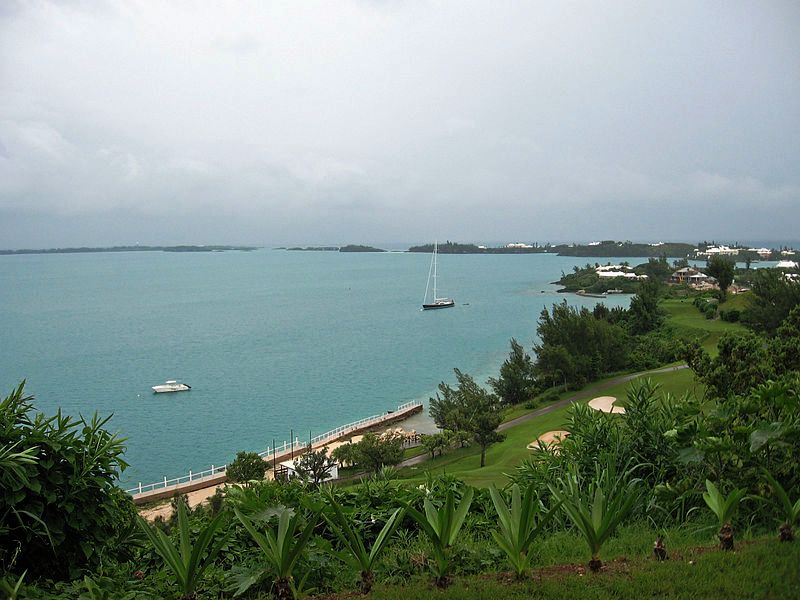
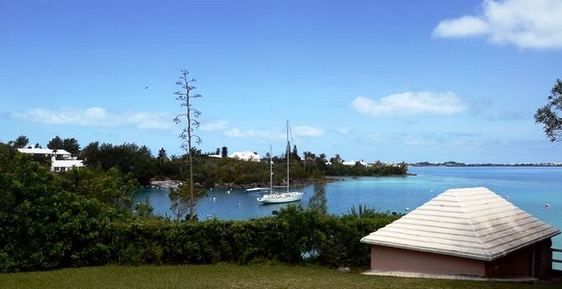
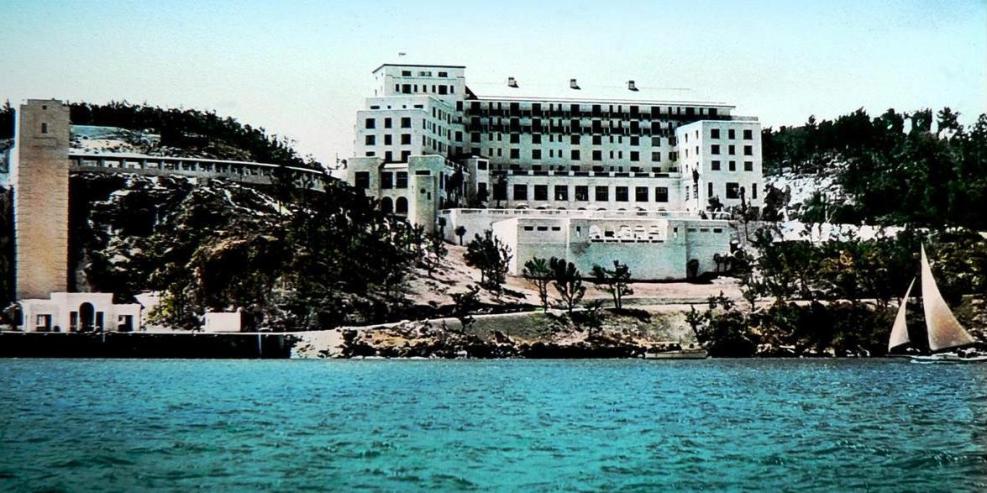
In the 1980s, the Marriott Hotel corporation acquired the hotel above, completed in 1931/1932 - but not the land - and saved but renamed the Castle Harbour Hotel. It became the much-changed in places Marriott's Castle Harbour Hotel.
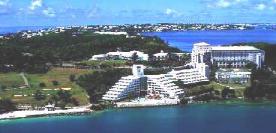
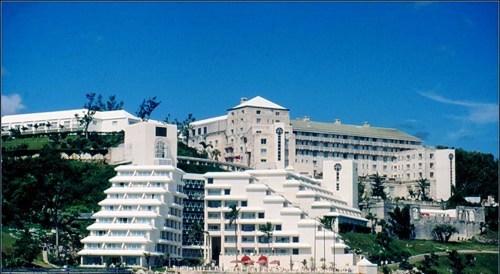
Later, Marriott's saved the old hotel, but added an unusual new development on the Castle Harbour side of it (as the photos above show). Millions of Marriott dollars were poured into it annually for years. Marriott's finally ceased its lease after incurring huge annual losses no longer allowed to be borne by American taxpayers and the hotel was closed in November 1999.
The old hotel and Marriott additions were later torn down by Bermuda Properties Ltd and rebuilt as the Rosewood-managed Tucker's Point Hotel and Club (see photo immediately above and Bermuda Hotels), with expensive villas and condos as new attractions for the wealthy. It was ceremoniously declared open on April 17, 2009 by film stars Michael Douglas and his wife Catherine Zeta-Jones, both of whom then lived in Bermuda. Luxury homes and luxury town houses are on top of Ship's Hill, almost directly above Church Cave.
![]()
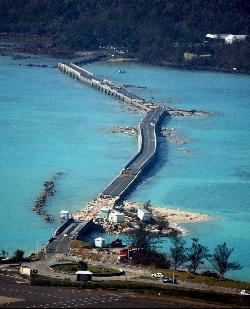 Hamilton Parish Side.
The Causeway itself is not merely a bridge as often assumed by visitors. It
spans Castle Harbor as a series of flat and arch spans. It is the narrow,
man-made strip of land linking Hamilton Parish with St. George's Parish.
It was first built in 1864 by the Bermuda Government, rebuilt in 1871 after the
first hurricane and originally stretched from Blue Hole Hill to and through Long
Bird Island. It is the
only link between St. George's, the Airport and the rest of the Island. .
Hamilton Parish Side.
The Causeway itself is not merely a bridge as often assumed by visitors. It
spans Castle Harbor as a series of flat and arch spans. It is the narrow,
man-made strip of land linking Hamilton Parish with St. George's Parish.
It was first built in 1864 by the Bermuda Government, rebuilt in 1871 after the
first hurricane and originally stretched from Blue Hole Hill to and through Long
Bird Island. It is the
only link between St. George's, the Airport and the rest of the Island. .
At one point it linked up with the old Swing Bridge to St. George’s. When construction began at the US military base Kindley in 1941, part of Long Bird Island was demolished, and the passageway between the islands filled with dredged material to create the airfield. It has been rebuilt several times again because of hurricane damage.
Longbird Bridge is at the airport end of the causeway and is so-called because it was part of Longbird Island until 1942. Where the nearby airport and adjacent area is now was was once a line of islands, Jones', 2.5 acres; Little Round, Long Cay, Round and Sandy. Long Bird Island, once 62 acres, was the biggest of these islands. This bridge, the smaller of two swing bridges in the area, is a two-span steel girder with an open grating traffic deck. In its closed position, it lets traffic pass over it and is supported at the east and west abutments and at the pivot pier immediately under the control house. When the bridge is opened to allow the passage of boats, all road traffic stops on either side of the bridge and the east and west supports are withdrawn. In this position, the bridge becomes a balanced cantilever supported only on roller wheels on the pivot pier. It can then be rotated by hydraulic rams to its open position. In this condition, balance is provided by a concrete counterweight on the bobtail span and the bridge cannot carry traffic.
2017. December 8. British firm Ramboll will be paid $400,000 to design the replacements for Longbird Bridge and Swing Bridge, Lieutenant-Colonel David Burch said today. The public works minister revealed both bridges have a lifespan until 2021, and that he expects Ramboll’s study to be completed by January so that rebuilding can begin. Colonel Burch also assured MPs that the Causeway is sound, adding: “There is no structural or economical argument to support the construction of a new Causeway.” Swing Bridge, the gateway to St George’s built in the 1960s, has fallen into disrepair in recent years and no longer opens to shipping. Longbird Bridge, a 60-metre twin carriageway bridge at the east end of the Causeway, was built in the 1950s. It closed to traffic ten years ago, when it was bypassed with twin Bailey Bridge structures. Colonel Burch told the House of Assembly: “Over the past decade, there has been an increased awareness of the significance of bridges to our nation’s economy and the safety of the traveling public. At all levels of government, a concerted effort has been made to reduce the number of structurally deficient bridges that require significant maintenance, rehabilitation, or replacement. Corrosion is a serious threat to the long-term function and integrity of a steel bridge. This is true for all bridges, but it is more serious in Bermuda where salt water and warm weather are the perfect storm to accelerate corrosion on a steel structure.” Colonel Burch said the typical lifespan is 50 years for bridges such as Swing and Longbird. He said: “Our latest studies on the Swing Bridge show that this bridge will have to be replaced within five years. The work completed earlier this year will allow us to extend its lifespan until 2021, but it is time to rebuild this essential piece of infrastructure.” He said of Longbird Bridge: “It was condemned several years ago. Two single spans of Bailey bridge were erected to accommodate traffic as a temporary solution. This temporary solution was put in place in 2007. Accelerated corrosion on these bridges forced us to change deck plates earlier this year. In ordinary climate conditions, these plates should last 25 years, but in Bermuda they lasted only ten years. This bridge is safe, but its lifespan is similar to that of the Swing Bridge.” He said of the Causeway: “Several inspections were performed on the Causeway and various scenarios were also looked at to see what would be the best improvement, for both safety and investment for the taxpayer. The Causeway is an old structure, but I am pleased to advise that the Causeway is sound.” Colonel Burch said the design contract was tendered in February this year. He described Ramboll as an award-winning, experienced engineering company which has completed many successful bridge projects around the world. He said with modern technology the target lifespan of the new bridges will be 100 years. Colonel Burch added that Ricardo Graham-Ward, a young Bermudian engineering trainee, will undergo a six-month secondment with Ramboll as part of the contract. He said: “This secondment will allow this young Bermudian civil engineer the opportunity to work on this project at the very beginning and be trained by the best moveable bridge engineers in the world. I am certain this attachment will provide him with invaluable training and experience that would otherwise not be available to us.”
2017. December 5. Replacements for Swing Bridge (St. George's) and Longbird Bridge are in the pipeline after a contract for design work was handed to a British team. Both of the East End structures have suffered major deterioration in recent years, and Swing Bridge was subject to emergency repair work under the One Bermuda Alliance government. A press release from British firm Double Unit announced a contract for full design services has been awarded to lead consultant Ramboll, Knight Architects and Eadon Consulting after an international tender. The two bridges form a critical link in the infrastructure of Bermuda, connecting LF Wade International Airport with Hamilton to the west and the Town of St George to the east. Longbird Bridge was originally constructed in the 1950s as a 60 metres-long twin carriageway steel swing bridge at the east end of the Causeway connecting the island with the airport. However, the bridge closed to traffic ten years ago and was temporarily bypassed with twin Bailey Bridge structures. Swing Bridge spans 120 metres across Ferry Reach, linking St George’s Harbour with the west of the island, and is a critical link for both vehicular and marine traffic. The 1960s swing bridge has received extensive refurbishment and remains open to vehicles but no longer opens to shipping. According to the press release, the design team will undertake studies to determine the most appropriate solutions for the new bridges, including fixed and moveable structures. It added that robustness and durability are key factors as both existing bridges have suffered accelerated deterioration in the tropical climate, which is particularly aggressive to steel structures. In addition, the structures and their mechanisms must be designed to withstand the hurricane-force winds that Bermuda periodically suffers. The design team have collaborated on many bridge projects and between them are responsible for award-winning moveable structures, including the Twin Sails Bridge, Poole (Britain), Gateshead Millennium Bridge (Britain), Lower Hatea Crossing (New Zealand) and Merchant Square Bridge (Britain). Commenting on the appointment, Peter Curran, bridges director at Ramboll, said: “We are all delighted to be working on such an exciting project with the Government of Bermuda. We look forward to collaborating to deliver a strong and lasting landmark for the island, one which inspires, connects and can endure the heavy weather conditions that Bermuda has previously suffered.” Martin Knight, director at Knight Architects, said: “Bermuda is a beautiful and inspiring location for any designer, and it is clear how important these connections are in the everyday life in the island. These bridges are also the entry point for countless tourists every year and they offer an opportunity for gateway structures which reflect the culture and identity of a truly unique place.” Work on the project will start immediately.
Bumping over the old barge bridge became a thing of the past in late 1952 when Kindley AFB's new Long Bird Bridge. built by the US Military, was officially opened. (Technically, at that time, it was part of what had been since 1941 the leased Kindley Air Force Base of the US Army Air Corps, later the USAF).
 53
years old in 2003, its lifespan of 50 years was almost over.
53
years old in 2003, its lifespan of 50 years was almost over.
The Bermuda Government announced in July 2000 plans to replace the bridge with a fixed-span overpass giving clearance of between 30 and 40 feet to marine traffic passing below it but this was done. Instead, repairs in 2001 extended its life. Engineers ere not in favor of replacing the bridge with a new swing bridge because the more moving parts there are, the more likely it is that corrosion and breakages will occur, especially in an exposed location.
Photo by Keith A. Forbes
In 2002, the US Government, in lieu of all other Bermudian claims that the USA caused serious environmental damage at the former US Naval Air Station nearby and Naval Annex in Southampton Parish, gave the Bermuda Government US$11 million, equivalent to the replacement cost of Longbird Bridge.
Some re-construction in mid-2003 reinforced the flat spans, casting them as arches. Only one lane was open to traffic until completion in August 2003. The construction caused long, tiresome delays, made worse by timed traffic lights which mopeds and scooters use illegally by going in front, much to the annoyance of persons in cars, trucks and taxis.
It was damaged extensively with a death involved, during Hurricane Fabian of September 2003. On Friday January 26, 2007, it was closed for four hours, nearly 500 people went without power and hundreds of schoolchildren and workers were sent home as hurricane force winds battered Bermuda. With gusting winds hitting 75 knots, flights from Bermuda International Airport and ferry services were also cancelled. Public Safety Minister David Burch shut the Causeway at 1.30 p.m. for safety reasons, with sustained winds at 45 knots. It remained shut until winds dropped at about 5.30 p.m., leading to scores of frustrated motorists in lengthy tailbacks. All Government schools were closed at lunchtime after power outages at five schools across the country, with a number of private schools following suit. In the afternoon, a Continental flight from Newark was delayed, while JetBlue and Delta’s Atlanta flights were cancelled because the closure of the Causeway meant people could not reach the airport. People called the Government to complain about the closure of the Causeway, but it was done for public safety. Government had set guidelines to shut it in strong winds in the light of Hurricane Fabian in 2003. Following Fabian, the Government took the stance that when wind speeds rose above 45 knots the Causeway would be closed to vehicular traffic.
In mid 2007, work began on replacement bridge being erected alongside the original. Traffic was restricted to one-lane traffic for almost two months after it was deemed unsafe due to storm damage. The intention is for the replacement bridge to ease traffic, while a five-year programme of maintenance work is carried out by the Ministry of Works and Engineering.
On February 23, 2009 it was announced the new Causeway will cost up to $90 million but most of this will be funded by private developers. Government will push ahead with a replacement bridge, and will seek a Public Private Partnership (PPP) to pay for it. Geotechnical investigations obtain information on the physical properties of soil and rock around a site prior to designing structure foundations. Engineers will carry out the study in order to identify where the bridge footings will be located. Construction of the new causeway could take up to three years. The start date for construction is currently under review.
The initial design was a high level concrete bridge without an opening span to be built on a curved alignment to the south but close to the existing Causeway. Halcrow Group Limited of the UK has been contracted to undertake the feasibility study and the architects are currently Dissing and Weitling. The Ministry of Works and Engineering is currently undertaking a feasibility study to determine the suitability of PPP for the procurement of a New Crossing, Castle Harbour." A Public Private Partnership is an agreement with developers, investors, construction companies and other service providers to finance, build and operate assets such as highways, hospitals, schools and power plants in a long term funding contract. Government began public consultation and a feasibility study into the New Crossing in 2006.
![]()
Situated in the grounds of the Grotto Bay Hotel. Well worth seeing, especially for those not familiar with caves systems. Bermuda's caves are unique. Featured on a 2002 $1 Bermuda postage stamp. Believed to be connected underwater with Prospero's Cave.
![]()
Wilkinson Avenue, Hamilton Parish. A lovely historic Bermuda manor house property built in 1907 in the colonial architecture style. Its features include traditional Bermuda architecture such as a cedar staircase in the front hall. One of its early inhabitants was William Wilkinson, a crew member on-board the Eliza Barss (thus later, in the 1950s, the name of a Bermuda grocery store) that sailed from New York delivering cattle to British soldiers in Bermuda. Mr Wilkinson later became an American citizen and joined the US Coast Guard. On February 2, 2018 the United States government bought the property which had earlier served as the official home for the Consul General. The US had leased Cedarhurst for the past nine years. Consul General Mary Ellen Koenig. Cedarhurst was secured under a trust before its purchase by the US.
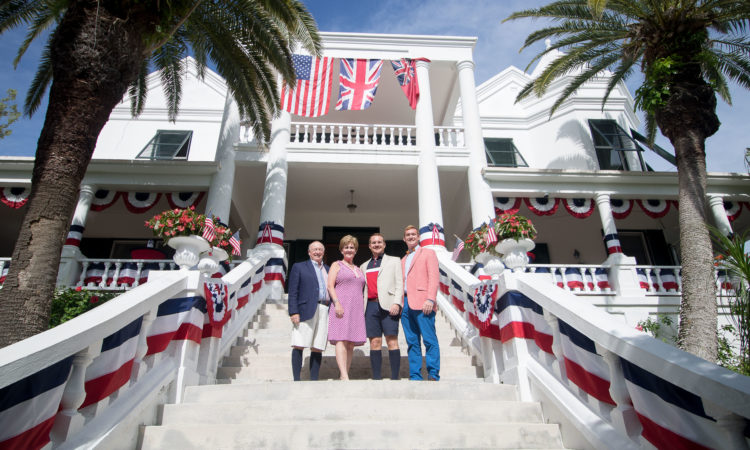
Cedarhurst, see above.
![]()
Bermuda’s shoreline was once dotted with man-made fish ponds that were used for centuries as a simple larder to store fish and turtles — but faded from use with the advent of refrigeration. The three Crawl areas here in Hamilton Parish - with Crawl the name of the area in which each are located - all take their name from the storage ponds of that name, similar to the word “corral” as a pen for livestock. Now, they are largely forgotten. These storage ponds were a distinctively local innovation. Bermuda is the only place where they were widely used — other than Hawaii, where a similar geology of limestone on top of volcanic rock is found.
![]()
8 Crystal Caves Road, off Wilkinson Avenue, Bailey's Bay, CR 04. Phone (441) 293-0640. Fax (441) 293-7334. Email info@caves.bm. Bus routes 1, 3, 10 and 11 stop nearby, at the Swizzle Inn. For moped users, there is free parking. Open daily, 9 am to 5 pm, last tour 4:30 pm. Reservations not required. The property is owned by the local Wilkinson Trust. If you are disabled or a member of your party is, or have limited mobility and encounter difficulty with slopes or steps, telephone or email to ask if the facilities/galleries can be accessed. Admission per adult can be for one or two caves (both are quite different in many respects and both should be viewed), less for children. One of Bermuda's outstanding scenic attractions. With beautiful examples of Mother Nature's underground architecture over millions of years. Bring a light sweater to wear in the cave. It was first discovered in 1904 by Carl Gibbons and Edgar Hollis, two local boys searching for a lost soccer ball and opened to the public three years later. Ever since then they have been tourist attractions, with Crystal Cave featured on a 2002 70-cent Bermuda postage stamp. See stalactites, stalagmites, ice soda straws, helectite formations and crystal clear deep pools. There are underground passages galore, most too narrow to allow inexpert access. Over a single period of one hundred years, only one cubic inch of a formation in this magnificent Gothic Palace of columns is created from the microscopic particles of limestone suspended in the relentless drips of water. Bermuda’s caves are home to about 60 native and indigenous marine invertebrates, ranging in size from large shrimp to microscopic organisms, with some species found only in a single cave. Here, the water is 55 feet deep yet so clear the bottom can be easily seen. Mark Twain, who visited Bermuda repeatedly, visited here shortly before he died and loved it. In the 1950s, boys from what was then the local Boy Scout Cub Walsingham pack used to come down here regularly and swim, under supervision. Cavers galore internationally have explored this unique cave, the waters of which have not yet been completely explored and mapped for all to see. Only registered cavers are allowed to go below-ground, with permission obtained well in advance from the Wilkinson Trust.
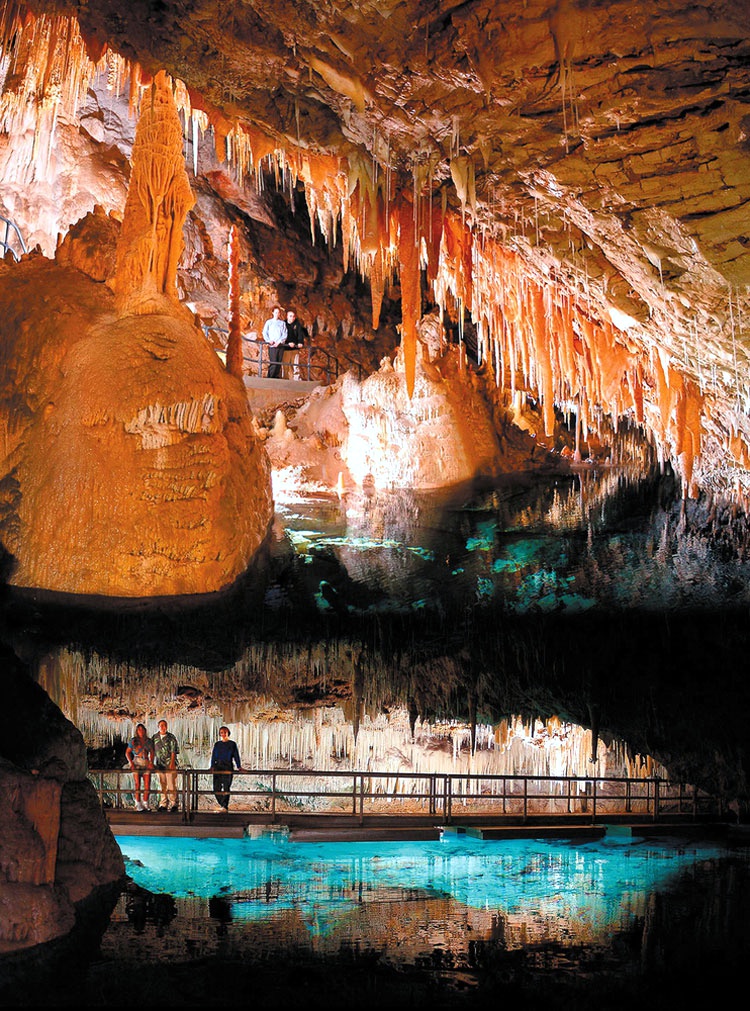
Crystal Caves, Bermuda. Photo: Bermuda Tourism
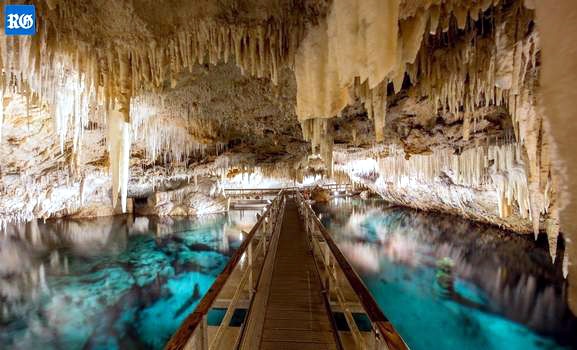
Crystal Caves, Royal Gazette photo
Fantasy Cave. Wilkinson Avenue, opposite the Crystal Cave. Buses 1, 3, 10 and 11 stop nearby. Also owned by the Wilkinson Trust. It was discovered in 1907 by Arthur E. Haycock and opened to the public as Wonderland Cave, but was closed in 1931. It re-opened on July 30, 2001 after some delays, as Fantasy Cave, re-developed and illuminated. It is featured on a 2002 35-cent Bermuda postage stamp. It is gorgeous, smaller than the Crystal Cave but with something quite different to see.
![]()
![]()
A 3.5 acre plot by Shelly Bay Park. It once had an inland tidal pond, thus the name, but this was filled in with sand from the dredging of Flatt's Inlet in the 1920s and 1941. Buy Back Bermuda (BBB) has been appealing for donations for its campaign to preserve this property for future generations. Campaigners from the Bermuda National Trust and Bermuda Audubon Society are involved.
2020. March 10. A pond filled in almost eight decades ago is to be reborn as a nature reserve. Excavators have moved in to the site of Eve’s Pond, at Shelly Bay in Hamilton Parish, as a first step towards the recreation of the pond and a three-and-a-half acre reserve by Buy Back Bermuda. Jennifer Gray, the chairwoman of Buy Back Bermuda, said the excavation might look “unsightly initially” — but promised to end with a beautiful open space. The project by Buy Back Bermuda, a joint venture between the Bermuda Audubon Society and the Bermuda National Trust, started last Friday. The site of the old saltwater pond, filled in 1941, was bought in 2012 by Buy Back Bermuda to be turned into a sanctuary for wildlife and public use. The pond used to rise and fall with the tide through a marine cave system that emerged in Harrington Sound. It will be restored as a shallow brackish pond for migrating and wetland birds, but will not be connected back to the caves to protect rare animal life underground. Excavated material from the old pond site will be used to create a roadside barrier to shelter the reserve from wind and traffic noise. The Eve’s Pond conservation management plan also includes walking trails around the edge of the pond and up into a woodland hillside. Phase two of the project will include a bird hide so wildlife can be observed at close quarters. The purchase and restoration of Eve’s Pond was made possible through a fundraising drive among the public led by the late David Saul, a former premier and businessman. Buy Back Bermuda said it planned to invite business and individual donors to enjoy the new park this summer.
2018. April 13. A plan to restore a pond filled in more than 75 years ago has been given the green light. The Development Applications Board backed a plan by Buy Back Bermuda to restore Eve’s Pond in Hamilton Parish as part of a nature reserve. Andrew Dobson, president of the Bermuda Audubon Society, said the organisation is happy that work could soon be under way. He said: “We really look forward to providing the public with another nature reserve that everyone can enjoy.” Mr Dobson added: “The plan is to create a brackish pond to provide a habitat for migratory ducks and other wetland bird species. Invasive plant species will be cleared, and the sand removed will be used to build an embankment along North Shore Road. This embankment will be planted with native and endemic plants. Just like our Buy Back reserves in Southampton and Somerset, there will be a nature trail with interpretive signage as well as an observation platform.” Eve’s Pond was a tidal, saltwater pond in Hamilton Parish until 1941, when it was filled with sand dredged from Flatts Inlet. The property on North Shore Road was bought by Buy Back Bermuda, which was launched by the Bermuda Audubon Society and the Bermuda National Trust. The original pond was about 50 metres wide and 100 metres long and was linked to Harrington Sound by the Green Bay cave system. The new pond will not connect to the caves in a bid to prevent further damage to the system.
2017. April 6. Hidden beneath the grass, soil and layers of sand dredged from the Flatts Inlet lies the remnants of Eve’s Pond. The Hamilton Parish pond was filled in the 1920s with dredged material that was pumped to the site by pipeline and few of the residents living in the surrounding Blink Bonny Estate neighborhood would have any idea it ever existed. But after years of research and preparatory work, David Wingate and a team of conservationists are looking to restore the old pond site back to its former glory as a haven for birds and other wildlife. Dr Wingate, who has been involved in nine pond restoration projects in the past half-century, told The Royal Gazette that he hoped the Buy Back Bermuda scheme would be submitting plans in the coming weeks. “No one would have known this pond ever existed if you were to look at it today,” he said. “It was a tidal pond that rose and fell with the tide through a cave system that came out in Harrington Sound.” The land where the pond once stood was donated to the National Trust and the Audubon Society as part of the Buy Back Bermuda scheme in 2013. But an additional hillside lot behind the pond had to be purchased in order to make the reserve large enough to incorporate an interpretative nature trail. Over the last few years extensive research has been done on the cave system leading to Eve’s Pond to ensure any restoration project would cause no damage. “The cave system leading to the Eve’s Pond site is the longest cave that has been mapped in Bermuda so it’s obviously important that we look after that,” Mr Wingate said. “We had a team of specialists in about two years ago who used state-of-the-art equipment to detect voids under the surface so we can map exactly what we will come across during the restoration. It has been a slow process and we will have to raise more funds to get the job done, but we are ready to push ahead with this project and will be submitting plans to the planning department for approval soon.”
![]()
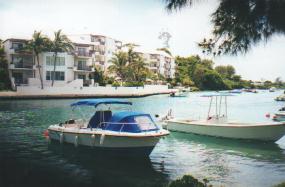 Midway between the City
of Hamilton and Town
of St. George, on the North Shore Road, after passing over Flatt's
Bridge, see above top photo, going east.
Route 10 and 11 buses stop in and near the village. Flatts village gets its name
from the shoals at the mouth of the inlet. It retains its atmosphere of calm
serenity in the face of the streams of water under and the streams of traffic
over its bridge. It is a magnificent lagoon, the only
one of its type in Bermuda. View it best from the dock opposite the Bermuda Aquarium, Natural History Museum and Zoo. Face
south for a view of Flatts Inlet, or north for Harrington Sound. Under Flatts bridge, the
water either surges into Harrington Sound from the Atlantic via Flatts Inlet, or flows out
in the reverse direction. It was once a prominent Bermuda port and a smuggler's
hideaway. Flatts Bridge was built between 1871 and 1877,
deliberately as a fixed structure not able to be raised or lowered to allow
larger vessels to pass though because the days when such large sailing vessels
used Harrington Sound for cargo or passengers or both had long gone. The days of
Flatts as an independent port are now long gone Today, the bridge, next
door to the Bermuda Aquarium and Museum, is part of the main North Shore
road linking Flatts with St. George's to the east and Somerset to the west. Often, see fish or squid flowing with the tide.
People gazing at
the tide rushing under Flatts Bridge are only partly correct in thinking
this is how Harrington Sound to the north of the bridge fills and
empties. The racing current is just a fraction of the daily ebb and
flow. Most of it slides silently through hidden caves and tunnels. There
is a vast underground labyrinth of them stretching the length of the
Parish and from coast to coast in the Parish. Most of the network is
entirely under water. Under water caves look exactly like above-water
caves. The Bermuda Cave Diving Association has lines connecting
them.
Midway between the City
of Hamilton and Town
of St. George, on the North Shore Road, after passing over Flatt's
Bridge, see above top photo, going east.
Route 10 and 11 buses stop in and near the village. Flatts village gets its name
from the shoals at the mouth of the inlet. It retains its atmosphere of calm
serenity in the face of the streams of water under and the streams of traffic
over its bridge. It is a magnificent lagoon, the only
one of its type in Bermuda. View it best from the dock opposite the Bermuda Aquarium, Natural History Museum and Zoo. Face
south for a view of Flatts Inlet, or north for Harrington Sound. Under Flatts bridge, the
water either surges into Harrington Sound from the Atlantic via Flatts Inlet, or flows out
in the reverse direction. It was once a prominent Bermuda port and a smuggler's
hideaway. Flatts Bridge was built between 1871 and 1877,
deliberately as a fixed structure not able to be raised or lowered to allow
larger vessels to pass though because the days when such large sailing vessels
used Harrington Sound for cargo or passengers or both had long gone. The days of
Flatts as an independent port are now long gone Today, the bridge, next
door to the Bermuda Aquarium and Museum, is part of the main North Shore
road linking Flatts with St. George's to the east and Somerset to the west. Often, see fish or squid flowing with the tide.
People gazing at
the tide rushing under Flatts Bridge are only partly correct in thinking
this is how Harrington Sound to the north of the bridge fills and
empties. The racing current is just a fraction of the daily ebb and
flow. Most of it slides silently through hidden caves and tunnels. There
is a vast underground labyrinth of them stretching the length of the
Parish and from coast to coast in the Parish. Most of the network is
entirely under water. Under water caves look exactly like above-water
caves. The Bermuda Cave Diving Association has lines connecting
them.
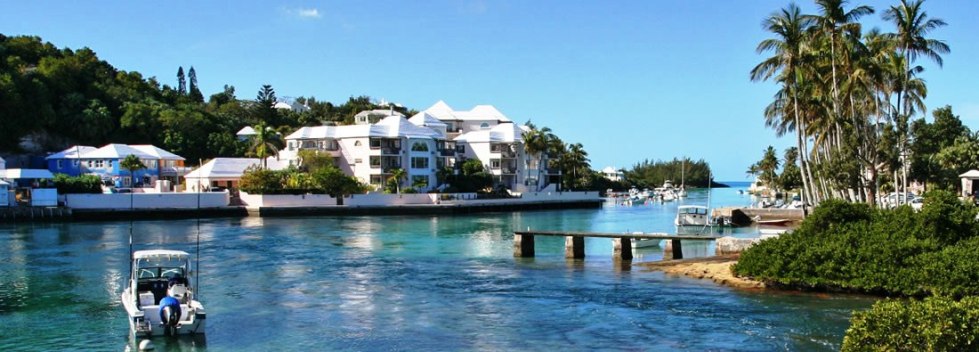
Flatt's Inlet, from Flatt's Bridge
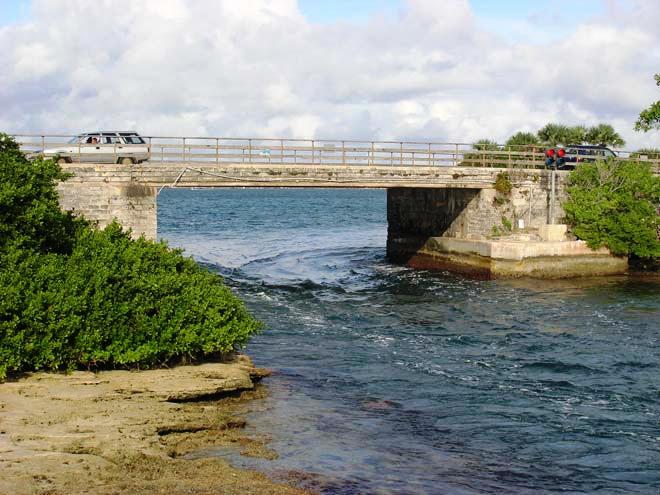
Photo by author Keith A. Forbes
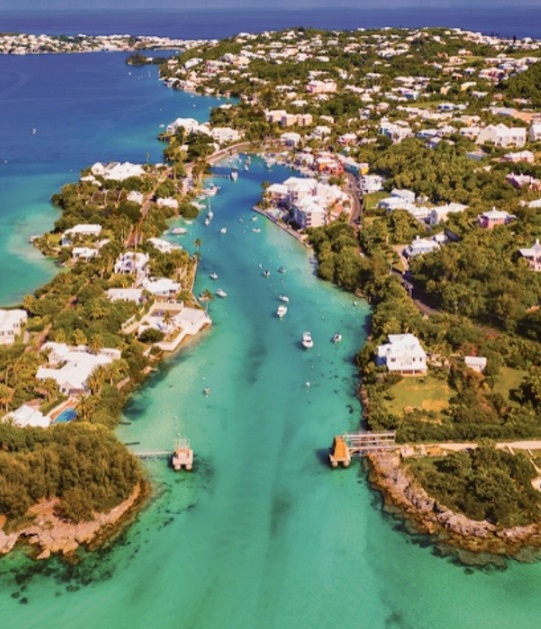
Flatts Inlet, from the air
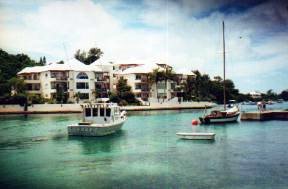
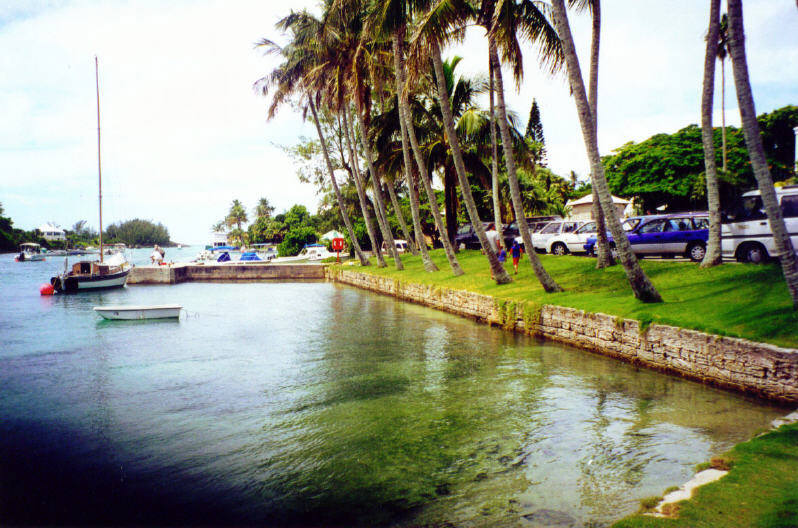
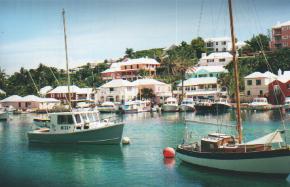
Four Photographs above and below by author Keith A. Forbes.
Experienced cave divers, local or visiting, can find out more. Elsewhere in the village, major wharf improvements have occured, complete with construction of a sidewalk, lamp posts, a grounded seat wall and two steps separating the sidewalk and the dock. On a Saturday every October, the Flatts Festival takes place here, with traffic banned, with artists and other attractions. The attractive condominiums on the south side of Flatts Inlet are St. James's Court built by insurance firm Liberty Mutual, of Boston, Massachusetts. Flatt's Village has lovely (expensive) condominiums, guest accommodations, restaurants, small shops and docking. It was once the haunt of smugglers. For people who arrive by bus, it is an attractive village. But for those who come by moped or scooter or car - and the elderly or disabled - the road is narrow, there is still no sidewalk or pavement through the village itself, traffic is usually heavy and there is no parking.
Flatts in 1930s then with Frascati Hotel (became the Coral Island Hotel, later demolished for condominiums). Photo taken in 1952.
Its main street is not all that much changed from that which existed when the port was in its prime in the 1700s, except that the rows of warehouses that lined the bustling thoroughfare now house other things instead of liquor and provisions. Once there was a travelers' inn, now a private home called Wistowe, situated on the eastern bank of the inlet. It was the scene in 1742 of Bermuda’s most famous duel. Newly-wed Peter Nice, angered by the attention being paid his young wife by bachelor Robert Hill, struck that tormentor across the face with his glove. He was immediately challenged to a duel. What had started pleasantly as a society ball turned into a tragedy as the two angry men fought with swords in the moonlight at the very water’s edge until Nice was run through and killed. Hill was acquitted both at the subsequent trial and at a second protracted hearing brought by the victim’s relatives on the grounds that the first jury had been bribed. During the American Civil War of the 1860s Wistowe was lived in by the American Consul Charles Maxwell Allen and his wife and daughter. Allen died in Bermuda at Wistowe and was buried in the churchyard of St. Mark's Church not far away.
![]()
11 Blue Hole Hill, North Shore Road, Bailey's Bay, Hamilton Parish. Phone (441) 293-8333. Fax (441) 293 2306. Reservations 1 (800) 582 3190 in the USA or 1 (800) 463 0851 in Canada. 201 rooms newly refurbished, for 500 guests. The hotel is on Castle Harbour part of the North Shore ocean. Nearest hotel to the Bermuda International Airport 1 mile or 5 minutes away. On 1, 3, 10 and 11 bus routes. Situated on 21 acres of landscaped ocean-front grounds. The 11 cottages in which the rooms are located feature hibiscus, oleander and bougainvillea gardens. Superior rooms are the first-floor rooms, while the deluxe rooms are second or third floor. All ’Ocean Front’ rooms are located along the water front; ’Ocean View’ rooms are on the top of a ridge that features fantastic views. In-room amenities consist of a coffeemaker, iron and ironing board, mini-refrigerator, hair dryer, reading lights and a safe. Complimentary Wi-Fi is available throughout the resort. With several man-made beaches, 4 plexi-paved cork-based tennis courts and exercise room, two historic underground caves for exploration and swimming, several restaurants. Offers most of all-inclusive as an optional extra, only hotel in Bermuda to do so, or various meal plan packages such as breakfast and dinner or just breakfast.
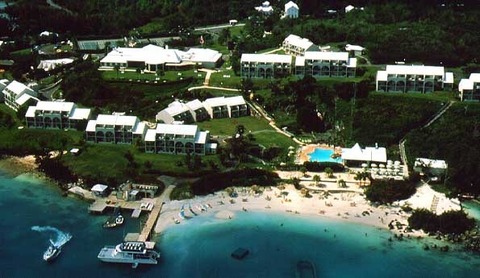
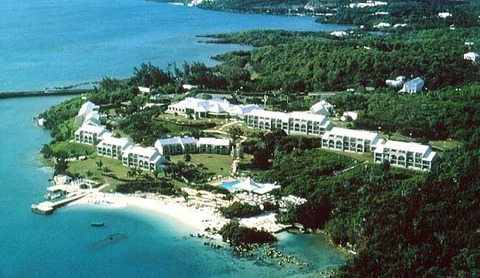
![]()
Appointed under the Parish Councils Act 1971. See under "Parish Councils" in Bermuda Government Boards. Appointees are political and meetings are not open to the public, unlike in the United Kingdom, Canada and USA where parish or community councils always are.
![]()
 A
large inland lake. The Hamilton Parish coastline and
points of interest of this large inland lake (see photo below by author) are
lovely. The Sound
was named after Lucy Harrington, a wealthy and influential women in the
Elizabethan era who did so much for the Parish. In its own way, Harrington Sound is as
glorious as the lakes of New Hampshire, Maine, and the Lake District of England,
for fishing, swimming, sunfish sailing, kayaking. It is not the crater of an extinct
volcano as often assumed. Its islands include Hall's Island, Rabbit Island and Trunk
Island. Some are inhabited year round. View its many facets
from the Harrington Sound Road.
A
large inland lake. The Hamilton Parish coastline and
points of interest of this large inland lake (see photo below by author) are
lovely. The Sound
was named after Lucy Harrington, a wealthy and influential women in the
Elizabethan era who did so much for the Parish. In its own way, Harrington Sound is as
glorious as the lakes of New Hampshire, Maine, and the Lake District of England,
for fishing, swimming, sunfish sailing, kayaking. It is not the crater of an extinct
volcano as often assumed. Its islands include Hall's Island, Rabbit Island and Trunk
Island. Some are inhabited year round. View its many facets
from the Harrington Sound Road.
There are lots of bays, caves, cliffs and coves, but not many beaches. Harrington Sound marks the lowest point on the Bermuda sea platform. It is quite deep, about 23 meters (about 70 feet) at Devil's Hole. Its geological formation is not yet fully explained. Under Flatts bridge, the water either surges into Harrington Sound from the Atlantic via Flatts Inlet, or flows out in the reverse direction. Flatts Bridge was built between 1871 and 1877, deliberately as a fixed structure not able to be raised or lowered to allow larger vessels to pass though because the days when such large sailing vessels used Harrington Sound for cargo or passengers or both had long gone. The days of Flatts as an independent part were a thing of the past. Today, the bridge, next door to the Bermuda Aquarium and Museum, is part of the main North Shore road linking Flatts with St. George's to the east and Somerset to the west.
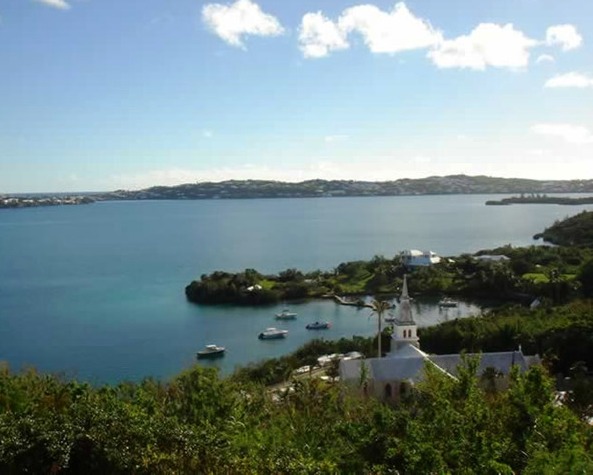
![]()
![]()
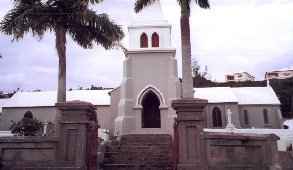 Trinity Church Road,
Church Bay, Harrington Sound.
Trinity Church Road,
Church Bay, Harrington Sound.
This is the third oldest of the Anglican Parish churches in Bermuda, dating back to 1623.
The tower and spire were added in the 1890's, gifts of Bermudian William D. Wilkinson, who studied architecture in Toronto, Canada.
The bell in the tower was from the foundry of Mencely & Co. of West Troy, New York.
Weighing more than 1, 211 pounds, it was placed in memory of the Reverend Alexander Ewing, Rector of the Parish from 1791 to 1817.
The graveyard overlooking the water is tranquil.
![]()
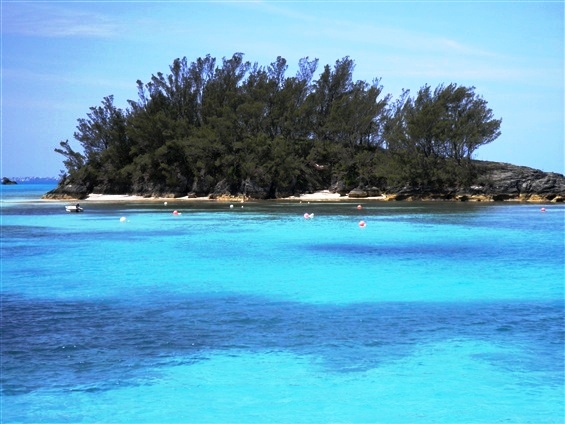
You can easily swim to this island and enjoy its low-tide beaches shown, from Bailey's Bay mentioned above.
![]()
Partly in both Hamilton and St. George's Parishes. It goes over the water, part of Castle Harbour.
2018. September 25. New designs for Longbird and Swing Bridges will be unveiled soon The Ministry of Public Works described the designs as “unique landmark structures which will reflect Bermuda’s welcoming culture”. They will on display at an information session at Penno’s Wharf, St George’s, from 6pm. British firm Ramboll is being paid $400,000 to design the replacements for the two bridges which are both expected to reach the end of their useful life in 2021. Swing Bridge, linking St David’s to St George’s, was built in the 1960s and has fallen into disrepair in recent years. The bridge no longer opens for passing boats. Longbird Bridge, a 60-metre twin-carriageway bridge at the eastern end of the Causeway, was built in the 1950s. It closed to traffic ten years ago when it was bypassed with twin Bailey bridges.
![]()
1 Mid Ocean Drive, Tucker's Town, Hamilton Parish. Or by airmail at P. O. Box HM 1728, Hamilton HM GX. Telephone: (441) 293-0330. Fax: (441) 293-8837. Hotel and resort. 21 rooms and suites. Cottage colony and Private club. Must be a member or referred by one to stay. For the affluent. This property was one of those begun by the British shipping organization Furness Withy in the 1920s that really began Bermuda's climb in tourism. On a 640-acre estate in the most exclusive area of Bermuda, with numerous beautiful residences and 3 large private beach areas, unique features of which are natural arches, plus coves on the estate, accessible by a private road to the Tucker's Town peninsula usable only by Club members. The world-famous Mid Ocean 18-hole golf course was first laid out by Charles Blair MacDonald, who created what became the National Golf Course in the USA. It is often ranked as one of the 10 best golf curses in the world. There are also 2 tennis courts and a tennis pro. With fine dining in its own restaurant, plus a Beach Cafe. It has received the Bermuda Government's Tourism Longtail Merit Award. On bus route # 1.

Photo: Bermuda Tourism
![]()
1 Mid Ocean Drive, Hamilton Parish (East End). Phone (441) 293-0330. Fax (441) 293-8837. Designed originally by Charles Blair MacDonald to fit into the natural terrain. It was a par-71 layout, over 600 acres of rolling countryside, 6,519 yards from the back tees. MacDonald won the first US Amateur Golf Championship in 1895 and later designed the National Golf Course in the USA. The course first opened in 1922. Ralph A. Kennedy of Mamaroneck, NY, regarded at the time as the "Dr. Livingstone of Golf," rated it one of the five best courses in the world in the 1920s. In recent years it was once ranked 45th by Golf Digest for courses outside the USA. Bermuda's number one private course. It was revised in 1953 by international golf course architect Robert Trent Jones. US Presidents Dwight Eisenhower, John F. Kennedy, Richard Nixon, George H. W. Bush and Jimmy Carter have played here, as well as the Duke of Windsor in 1940, British Prime Ministers Sir Winston Churchill, Harold MacMillan and Edward Heath. Golf professionals Robert Jones, Sam Sneed and many other celebrities also have golfed here. When Babe Ruth, normally as good with a club as he was with a bat, played the 433-yard fifth, known as the "Cape," he knocked eleven straight balls into Mangrove Lake before finally driving one over the hazard. In the 1990s this course hosted the Merrill Lynch Classic and later the Gillette Classic. The first three holes run parallel to the ocean. All the greens were re-built in 2002. A private club, an introduction is needed from a member, or try an hotel's Social Desk or cruise ship's Shore Excursion office.
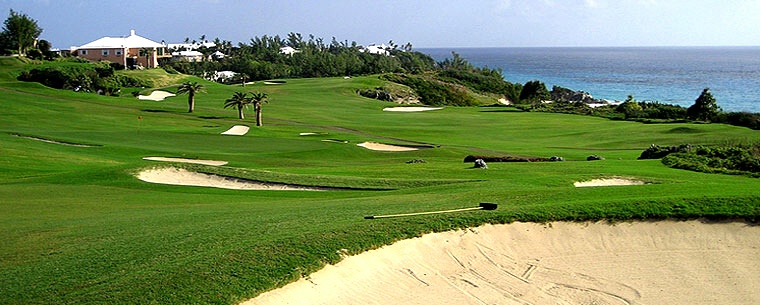
Photo: Bermuda Tourism
For visitors who arrive at the airport on one of the commercial airlines or cruise ships, the closest cruise ship berth is Town of St. George, about 5 miles away to the south west. If you bring your own clubs, you won't be able to go by public transportation (bus). Instead, take a taxi. If without clubs, take the # 1 bus to property and walk. Check rates directly with course depending on time of day and time of year. Private but will accept some off-the-street golfers by prior appointment if referred by a member. Ask about playability on the day you have in mind.
![]()
![]()
Close to Harrington Sound, with its center near the junction with Harrington Sound Road and Wilkinson Avenue. A large network of underwater and below-ground caves, some isolated, others part of smaller networks. It includes Crystal Cave and Fantasy Cave, referred to earlier.
![]()
Featured on a 2002 80-cent Bermuda postage stamp. It is situated in the grounds of the Grotto Bay Hotel. It is reputed to have been discovered in 1609 by Admiral Sir George Somers. Prospero is a character from "The Tempest" of 1610 by Shakespeare, the true-life details of which are believed to have occured in Bermuda, not a mythical Italian island.
![]()
See by name and Parish in Bermuda Cuisine.
![]()
60 Tucker's Point Drive, Hamilton Parish HS 02. Phone (441) 298-4000. Email Tuckerspoint@rosewoodhotels.com. So-called because it is professionally managed (but not owned) by the Rosewood corporation of Texas. Mailing address P. O. Box HS 85, Harrington Sound, Hamilton Parish, HS BX, Bermuda. Opened April 17, 2009 by Bermuda residents and film stars Michael Douglas and his wife Catherine Zeta-Jones, with then-Premier Ewart Brown, as the first new hotel to be constructed in Bermuda for 37 years. 88 guest rooms on a 20 acre development. They range in size from 530 to 1,200 square feet with luxury bathrooms and terraces with views of Castle Harbour and Harrington Sound. Rooms feature luxury bathrooms and terraces with views of Castle Harbour and Harrington Sound. Each room has a spacious balcony with a view of Castle Harbour, a flat screen panel TV, Wi-fi, fireplace, wet bar and walk in closets. They also have a luxury five-fixture bathroom with a stand alone deep bathtub. The rooms also come with amenities such as portable phones and I-pod/Mp3 docks and 24-hour room service. On 200 acres of waterfront overlooking Castle Harbour.
It is in the exclusive and private residential area of Bermuda known as Tucker's Town. Interestingly, while the hotel itself and its units are solely in Hamilton Parish, the Rosewood Tucker's Point Beach Club is in the St. George's Parish part of Tucker's Town, about a mile away. A resurrection, reconstruction and reconstitution of the Castle Harbour Hotel, which opened in 1931 and closed in 1999, under a new name after the latter's demolition. The Castle Harbour Hotel was a landmark first planned by the British Furness Withy shipping organization in 1923 and first opened on November 1, 1932. Furness Withy built both the original Castle Harbour Hotel and the Mid Ocean Club. After World War 2 Furness Withy of the UK lost interest. The property and extensive land were bought by Bermuda-based Bermuda Properties Ltd (BPL), originally headed and owned by Juan Trippe. He was the founder of the original Pan American World Airways. It was a direct result of his interest in Bermuda after Pan American flew between Bermuda and New York from 1937. His son, Ed Trippe, later a ssumed control.
Photo: Bermuda Tourism
The centre piece is the Manor House, perched above Castle Harbour. The Palm Court, which is lined with palm trees, leads from a croquet lawn to a horizon pool overlooking a lush grotto and Harrington Sound. The spa has 10 tranquil treatment rooms and a Silver Tag hydrotherapy suite, with the women's salon offering manicure, pedicure and styling. There is also a barber shop. The 1,900 square-foot fitness centre is fitted with aerobic and cardiovascular equipment, in addition to weights, offers private wellness and conditioning instruction, while the dive and watersports centre provides dive adventures aboard the 31-foot Tidal Pull exploring shipwrecks and underwater caves. Diners have the Point Restaurant, accessed via an English long bar facing Palm Court. Point Terrace and the wine room, with its barrel-vaulted ceiling and selection of new and old world wines, provides a more private experience, along with al-fresco dining poolside at the Mahogany Terrace. The conference facility comprises computers, translation, IT support and secretarial services, in addition to satellite conferencing and a projection screen.
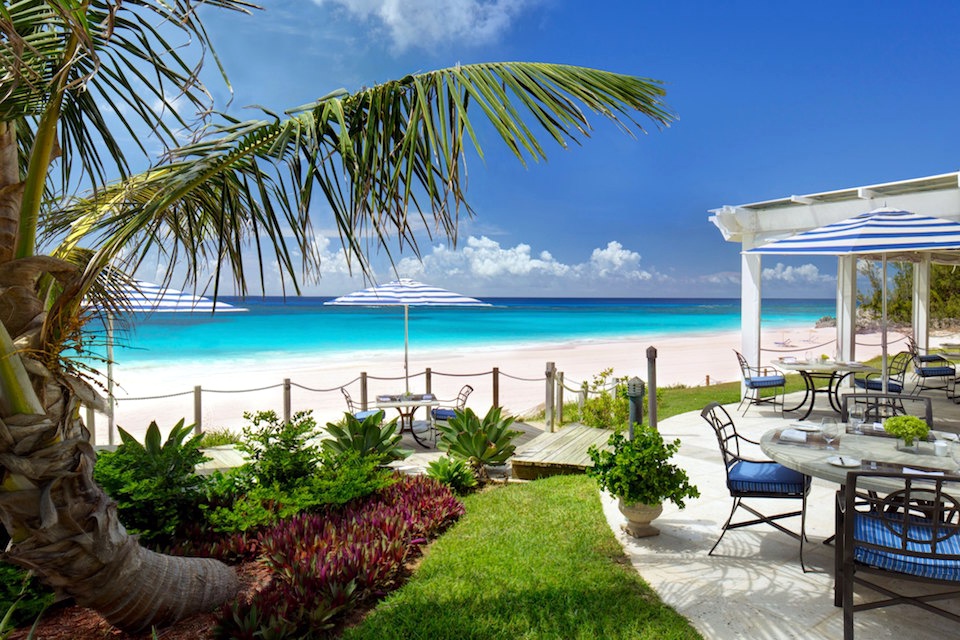
Rosewood Bermuda's beach club.
2019. October 24. An exclusive Rosewood Bermuda Rum is now being poured after it was unveiled last night. The rum is handmade under the direction of Jose Gomez, Bacardi Rums’ global master blender, and is such a limited edition that the supply will total only 326 bottles. The first 70 bottles are now being served at the hotel, near Tucker’s Town. The hotel and resort decided it wanted a rum, unique and specially made, and branded for it to serve to guests. Serge Bottelli, Rosewood’s director of food and beverages, visited the Bacardi facility in Puerto Rico and met Mr Gomez to set in motion the production of the special rum. Two months later, the first of the bottles were flown to Bermuda for the launch yesterday that coincided with a gathering of Bacardi executives at Rosewood. “It is an amazing product,” said Mr Bottelli. He and John Lake, the hotel’s bar manager, went to Puerto Rico to learn about the rum-making process from Mr Gomez. “We blended some rums by adding and taking out. Everyone agreed on what we had. We chose the bottle and label,” said Mr Bottelli. So how special is this rum? Mr Gomez said: “We had some casks put aside for this project. It had always been our dream to have [such] a barrel project.” He said it was a completely artisan, or handmade, operation. There was no bottling line. “In this blend, the youngest Bacardi rum is eight years old, and the oldest is 12 years, and this is undisturbed ageing,” he said, explaining that undisturbed ageing referred to a cask of rum that has matured over time with no disturbance. Mr Gomez said the filtration system used was also unique, as was the cask system — which could not be reproduced, hence the supply of the Rosewood Bermuda Rum being limited to 326 bottles. “This specific barrel project is something new for us. We have had special blends for specific consumers, but not in this way and with this degree of uniqueness,” he added. The rum has been blended to appeal to the palette of North Americans, who make up a large percentage of Rosewood Bermuda’s guests, and local residents who frequent the hotel and its bars. Mr Bottelli said it gives guests something special: “It is unique, you give more. We researched with master blender from Bacardi to have that perfect rum for the location.” The hotel has created some other exclusive food and drink choices, such as its own barrel of Tequila Patrón. “That came to 256 bottles. We have about 100 bottles left. So, we have our own Patrón, people like it and choose it. It is a bit different,” said Mr Bottelli. “Also, we have a beekeeper here, and I just bought five gallons of his honey.” The Rosewood Bermuda Rum is on sale at Tucker’s Bar, the Conservatory Bar, and the beach club and golf club bars. But what happens once all the special rum has been consumed? Mr Gomez said he hopes Rosewood Bermuda will request that he blends another unique rum for the hotel and resort’s exclusive use.
2019. March 4. Rosewood Bermuda’s managing director, Paul Telford, has stepped down. The hotel announced Mr Telford’s leaving today, but said he would continue to work with the property’s ownership group, providing hospitality consultation on their investments in Bermuda. Mr Telford joined the resort as part of the opening team in 2008 and worked in several roles at the property before taking the helm in 2015. A hotel spokesman said they were grateful for the outstanding leadership Mr Telford provided to Rosewood Bermuda over the last ten years. In the last year, Mr Telford led the Rosewood Bermuda team through a full renovation and successfully re-launched the property to great acclaim. He was also named as chairman of the Bermuda Tourism Authority, as an ambassador for tourism on the island. “He has played an important role in his work with Rosewood and Bermuda with his stewardship and passion as a hospitality professional,” the spokesman said. “We have the utmost respect for Paul, and thank him for his efforts and steadfast commitment to the resort, and wish him much success in the next phase of his career.” Rosewood is now searching worldwide for Mr Telford’s replacement. Until a formal managing director has been appointed, Remus Palimaru, hotel manager of the Rosewood London, has been brought in on a short-term assignment to oversee the daily operations of the hotel and to organize the property and team for the 2019 high season.
![]()
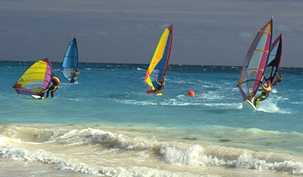 Off the North Shore Road in
Shelly Bay, midway between Flatt's Bridge and the Shelly Bay Plaza. Bus routes 10 and 11
to and from the Town of St.
George and City of
Hamilton stop here and offer a frequent service. It takes its name from Henry Shelly,
one of Bermuda's earliest colonists of the early 1600s who lived here.
Off the North Shore Road in
Shelly Bay, midway between Flatt's Bridge and the Shelly Bay Plaza. Bus routes 10 and 11
to and from the Town of St.
George and City of
Hamilton stop here and offer a frequent service. It takes its name from Henry Shelly,
one of Bermuda's earliest colonists of the early 1600s who lived here.
On the northern side is an old Bermuda-stone boat slip dating back to 1664, with scored cuts offering proof this was the great shipyard of Shelly Bay. That year the first recorded vessel in Hamilton Parish, the Bermoodian Aventure, was launched at Shelly Bay before going on voyages to London and the West Indies during the 1660s and taking part in the salt trade. At the time the shipbuilders would have seen the western tip of the island. Today, the principal feature of the bay is the beach, public, popular, shallow and safe for the family, with limited access for the disabled and a disabled-only parking space for a car (not close to the beach). It has shade trees providing welcome relief. It also a popular place for residents to camp out over the Cup Match holidays. The seascape from the beach stretches to the Bermuda Royal Naval Dockyard in Sandy's Parish. On windy days, it's a favorite place for wind surfers (see smaller photo) to fly across the deeper water of the bay, out of range of swimmers. There are a children's playground and park with many indigenous species of trees and shrubs; and a playing field for several organized sports near a former horse racing track. There was a restaurant on the premises (see below). Visitors today can see at the adjacent sports field area of the complex, what used to be for many years until the late 1930s, the Shelly Bay horse racing track. In 1937, Oliver Caisey, Sr. (with his race horse Fanny) became the first black jockey at the Shelly Bay race track. His groom was Claude (Poker) Furbert. It was a particularly popular place for British Army officers stationed in both Devonshire at Fort Prospect and in St. Georges, as it was exactly midway between them.
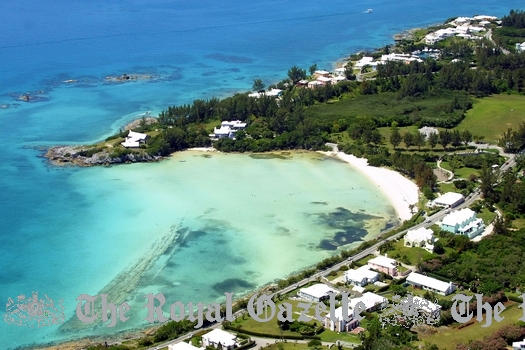
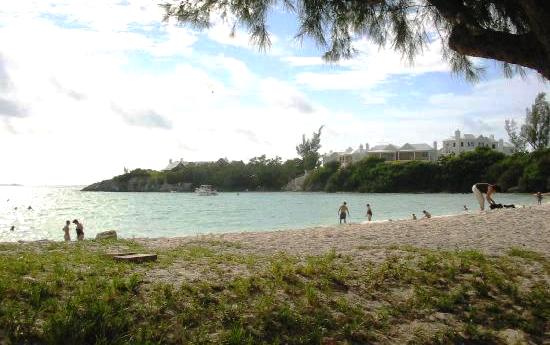
Shelly Bay Beach
2019. September 7. More than a year has passed since Government promised to look at ways to develop Shelly Bay to improve access for older people and the disabled. Campaigners who put forward the plan, as an alternative to a Bermuda Tourism Authority proposal to house food and beach equipment and rental concessions in re-modeled shipping containers at the Hamilton Parish beach, said they were confident work would be carried out in the near future. The Ministry of Public Works, however, declined to comment on when the redevelopment was scheduled or if cash had been earmarked for the project. Members of the pressure group, which included area residents Cheryl-Ann Griffin, Esme Williams and LaVerne Furbert, said earlier that it was their hope that the work would be completed in time for this year’s summer season. Ms Williams said this week that the group would follow up with the minister regarding the status of the plans. She added: “I am confident that the plans will go ahead and am hopeful that they will be included in the upcoming budget.” The Government last August blocked the BTA plan, part of its Beach Economy Vision, after public consultation. The public works ministry instead agreed to examine the campaigners’ proposal, which was backed by a petition with more than 1,000 signatures. The ministry organised a meeting in April and outlined plans for a gazebo, water wheelchairs and removable non-slip mats that would run to the water’s edge, as well as improved access to the beach. Derrick Burgess, the Deputy Speaker of the House of Assembly and also an area resident, was on the panel at the April meeting along with Lieutenant-Colonel David Burch, the public works minister, who said at the time that the plans were “not cast in stone”. Mr Burgess also refused to comment on the development and said it was a question for the public works ministry. The BTA hosted a taster event last August to allow potential concession operators to promote their businesses. Jamahl Simmons, the Minister of Economic Development at the time, said during the event that “we’re the ones that will make the final decision”.
2019. April 12. Plans to build a gazebo and improve access for seniors and the disabled at Shelly Bay Beach were welcomed by residents last night. The proposed scheme would include “water wheelchairs” and removable non-slip mats that reach the water. About 60 people attended a public meeting at Francis Patton Primary School, where Lieutenant-Colonel David Burch, the Minister of Public Works, said the plans were not “cast in stone” and that he welcomed the views of area residents. He said that seniors and beachgoers with physical problems were the priority “because Shelly Bay lends itself to catering for that constituency”. The new ideas came after a pressure group blocked a plan by the Bermuda Tourism Authority for concessions housed in shipping containers at the Hamilton Parish site. Blake Lambert, an architect and assistant project manager at the Bermuda Housing Corporation, who drew up the plans, said his goal was to “create some accessibility and community aspects” at the beach. He added the proposals included the erection of a gazebo and a building for bathrooms that would also encompass storage space for water-accessible wheelchairs and Mobi-mats, which are portable and can be rolled out to create a pathway over sand for people in wheelchairs or with other disabilities to reach the sea. Mr Lambert explained that by planting dense foliage, the bathroom building would be well-concealed once the plants matured. LaKiesha Wolffe, who lost her left leg after a near-fatal road accident nearly six years ago, said Shelly Bay was one of the few beaches that suited her for swimming because of its hard sand. She told the meeting she used crutches, a cane and a wheelchair and said she hoped consideration would be given to making sure that the bathrooms were built with the disabled in mind. Ms Wolffe later added she supported the proposals, but that she was worried about details like the level of sinks in the facilities, effectiveness of railings and availability of parking close to the beach. Mr Lambert said the bathroom designs would conform to standards laid out in the Americans with Disabilities Act. He added the doors to the restrooms would be on the water side of the building, in response to a question from a member of the public who was also concerned about accessibility. Esme Williams and Cheryl-Ann Griffin, who were part of a group that pushed for the proposals as an alternative to the BTA plans last year, were delighted with Mr Lambert’s blueprint. Ms Williams said: “Whatever we said, he just envisaged. When we saw the plan, we thought, wow.”
2019. April 11. Plans for a small concession area in Shelly Bay Park will be unveiled at a meeting this evening. The Ministry of Public Works will also present plans for access for seniors and the disabled at the beach at the event, to be held at Francis Patton Primary School. A ministry spokeswoman said: “The ministry is keen to ensure that any proposed additions or enhancements to the Shelly Bay Park area receive public input.” Tonight’s meeting will be held in the school’s gymnasium with a start time of 6.30pm. A Bermuda Tourism Authority plan to install concession stands at Shelly Bay Beach has sparked opposition from some residents near the popular Hamilton Parish attraction. A group of residents staged a protest at the BTA bid to use shipping containers to house temporary concessions by the North Shore beach as part of its plan to boost the beach economy. The residents proposed an alternative, which included improved beach access for the elderly and the disabled. The pressure group also requested improved restrooms for the park and said they would not oppose a lunch wagon.
2018. August 11. A $13,500 event at Shelly Bay beach was value for money, the chief executive of the Bermuda Tourism Authority said yesterday. Kevin Dallas said the cost of the promotion at Shelly Bay in Hamilton Parish on Thursday, which featured five island vendors, was based on the 445 adults who attended. He said: “It was clearly a worthwhile investment in support of small Bermudian businesses who would have difficulty putting on an event of this scope on their own. We commend the entrepreneurs who stepped up magnificently last night, especially since the crowds were far larger than expected.” The cost of the event was $61,500 cheaper than the figure suggested by LaVerne Furbert, an opponent of plans to install four vendors at the beach in temporary stores made out of old shipping containers. Ms Furbert, a trade union official, said on Facebook yesterday that the event would cost $75,000 and that people who attended would be “wined and dined at the taxpayers’ expense”. She added: “If the BTA spent $75,000 on this evening’s shindig, some heads definitely need to roll.” The event went ahead despite a decision by Jamahl Simmons, the tourism minister, that Shelly Bay would be removed from the BTA’s “beach vision” plan to revitalize five beaches around the island. Mr Dallas said: “The idea was not to create more Horseshoe Bays. It was to recognize the inherent character of each beach. Our focus now is to say there were five fantastic small Bermudian businesses who did a great job and proved that they can go above and beyond to deliver. I think our priority will now be to find opportunities to give those guys, possibly on a beach or somewhere else entirely. We would like to see those businesses rewarded for the efforts they have made.” Mr Simmons said “a concession of some sort” would be created at the beach instead, which would also be used for “occasional events”. Justin Mathias, OBA spokesman for tourism in the Senate, said the decision to back away from the plan was “sad. A BTA proposal to allow local vendors to use Shelly Bay would have supported small, black businesses and it is sad that it appears a few PLP supporters, disgruntled at the idea, managed to stop this plan in its tracks. Through increasing the loan facilities of the Bermuda Economic Development Corporation, Government is allowing small businesses to get access to more money but given the about-turn at Shelly Bay, they must make it clear how they are actually going to help entrepreneurs take advantage of opportunities when they arise. The BTA is fully funded from government coffers and up until Thursday the Minister of Tourism was supporting the BTA, so the amount spent on the event organized by the authority is, essentially, a waste of taxpayer’s money.” Mr Mathias added: “We were told that government revenues for the first quarter of this financial year were up, but if Government continues to waste money like this, that situation will be quickly reversed.”
2018. August 9. Protesters against a plan to create family-friendly attractions at Shelly Bay Beach said yesterday that they feared the Bermuda Tourism Authority would push ahead with its plans despite local opposition. One of the organisers of a group created to fight the BTA proposal to set up temporary concessions in old shipping containers at the beach said a protest would take place tonight to clash with a BTA event. LaVerne Furbert, a trade union official, said: “I’m calling for as many people as possible who are opposed to what the BTA is proposing to come out and let their voice be heard.” Ms Furbert said that the group was prepared to thrash out an agreement on the future of the beach with the BTA. She added: “I do believe the BTA is looking to move forward with their vision regardless of how the people feel, which is unfortunate. I would have expected that there would have been an attempt by somebody in authority to get everybody in a room and see if we can reach a compromise that is satisfactory to all.” She was speaking as the BTA prepares to hold an event at Shelly Bay designed to showcase the concessions available under its plan to improve the island’s beaches. The event will include the four finalists in a tender process to operate at the beach — three food vendors, and a beach and boat rental business. The BTA unveiled its “Beach Economy Vision” plan for five beaches, including Shelly Bay, in June. Ms Furbert was one of five area residents who outlined an alternative vision for the beach at a press conference this week. The group’s proposal called for the beach to be made accessible to people with disabilities, including a removable non-slip mat for wheelchairs down to the water, rather than adding concessions. Ms Furbert said her group planned to present the BTA with a petition against its plan with more than 1,000 signatures. She added she did not think samples from vendors were needed. Ms Furbert explained: “I think that most people know what Ashley’s Lemonade tastes like. As far as the Smokin’ Barrel, I think most people know what that tastes like.” Ms Furbert said that the group was not opposed to a food vendor but it did not want one on the beach. She added the group was also against chair and umbrella rentals. Ms Furbert said that she had been contacted by three of the four possible vendors. She explained: “I had to let them know that it’s nothing personal. It’s just that we want the beach kept as it is, a family beach without commercialization.” Glenn Jones, director of strategy and corporate communication at the BTA, said yesterday: “The Bermuda Tourism Authority has long believed listening to public feedback makes our beach economy plan stronger. It’s the whole point for what’s planned on Thursday evening, and we look forward to seeing everyone there, so they can experience what’s proposed and give further input.” Mr Jones said earlier that the BTA would support moves to improve accessibility at Shelly Bay. He added: “Our architect tells us that the proposal for a beach-access mat can easily be incorporated into the existing plan. We’ll work with our colleagues at the Ministry of Public Works to see if we can get it done.” Ms Furbert said: “What the BTA is missing is that we still do not want any concessions — those repurposed containers — on the beach where they propose to put them. That won’t go with us.” The BTA meeting will take place from 6pm to 8pm.
Shelley Bay Race track in the old days (long since gone) when this was a hugely popular local racing event.
![]()
Just east of Shelly Bay and Burch's Cove. Bus routes 10 and 11 drop you right outside the plaza. Shopping Plaza. J It has a do it yourself laundromat; full service grocery store; pizzeria; and clothing store. Budget for Bermuda prices, they stun many visitors. This local full service branch of The Marketplace grocery chain is open every day (Sunday from 1 pm to 6 pm). Phone 293-0966. Liquor cannot be bought in Bermuda on Sunday.

![]()
Bailey's Bay, corner of Wilkinson Avenue and Harrington Sound Road. Address is 68 Harrington Sound Road. Telephone 293-8606 or fax 293-0087. A stop on the African Diaspora Heritage Trail. Built in the mid 19th century by free blacks including former slaves.
![]()
Restaurant. See by name and Parish in Bermuda Cuisine.
![]()
Off Crawl Hill, Hamilton Parish. An historic small building with a gabled roof. Built by the Hamilton Parish Temperance Friendly Society in 1852, it became an elementary school in August 1857, offering instruction to 129 children—74 boys and 55 girls, in just one room. Rosalind Taylor Robinson was the headmistress there in 1936 when still a one-room school. In her time, there were 73 pupils with two other older teachers on the staff. It was a little country school very close to the sea…the spruce trees particularly made a good arbor—the children seated on the lower branches and the teacher seated in a chair beneath.” The school closed in 1950 when it merged with Francis Patton Primary School.
![]()
Tom Moore’s Jungle (accessed from Walsingham Lane, off Harrington Sound Rd.) is a natural mix of Bermuda cherry (hugely different from cherries of the UK, Europe, etc) tree forests, crystalline caves, and mangroves surrounding Tom Moore’s Tavern, a four-star restaurant housed in a 1652 waterfront inn. Both the tavern and jungle take the name of Dublin-born (then part of Great Britain so he was officially British, not Irish) Thomas Moore, an Irish poet–bon vivant, so hugely respected and venerated in the Republic of Ireland that there are gardens and numerous songs (as merely one example, the Last Rose of Summer) named after him. His romantic local verse early in his adult life during his brief stay (January to April 1804, during which time he was swindled, made to pay for another's wrongdoing, went back to the UK and later bitterly regretted ever having set foot in Bermuda) as an Admiralty (Royal Navy) court official registrar has perpetuated his name in local legend, if not fact. The Irish themselves never refer to him as Tom, always more respectfully as Thomas. Bermuda’s most famous tree, a calabash, is located here. Moore made it famous, using it's shade to compose his poems. From this fame, on November 4, 1844, members-to-be of what became the Royal Bermuda Yacht Club held their first meeting here.
Highlights of the area are swimming grottoes, fed via subterranean tunnels by the tides of Castle Harbour. Fish can often be seen in the turquoise water. The Castle Harbor coastline here is also perfect for snorkeling; the shallow bays and mangroves invite hours of exploration. Bird-watchers will enjoy spotting not only the many herons that stalk crabs on the shore, but finches, cardinals, and doves. Caves honeycomb the woodlands. Part of this chunk of land is the 1.25-acre Idwal Hughes Nature Reserve, named for the Welsh-born senior civil servant and Public Works Director and architect who came to Bermuda, married an American lady and subsequently had Bermudian children). It is owned by the Bermuda National Trust and contains indigenous palmettos and cedars, along with unique geological formations.
The region is also riddled with underwater caves, including the most famous, Crystal and Fantasy Caves, open to the public on payment of fees. Bermuda’s oldest rock, a very hard limestone estimated to be 800,000 years old, can be found at the surface in the Walsingham area.
2020. March 9. This park has joined a scheme to preserve forests in Commonwealth countries. The Walsingham Nature Reserve, known as Tom Moore’s Jungle, is the first in a British Overseas Territory to be accepted by the Queen’s Commonwealth Canopy. The QCC, a network of forest conservation efforts throughout the British Commonwealth, promotes collaboration among conservationists and the sharing of knowledge. Karen Border, president of the Bermuda Audubon Society and a member of the Walsingham Trust, said: “The Walsingham Nature Reserve is one of Bermuda’s most important ecological sites and a special gem of open space that is dear to many Bermudians. The Bermuda Audubon Society is delighted that its value to the community has been recognised with The Queen’s Commonwealth Canopy accreditation.” Samantha Cohen, co chairwoman of Cool Earth, a charity and QCC managing partner, said: “We are delighted that Bermuda has joined the QCC, dedicating the Walsingham Trust Nature Reserve as their project. This key conservation area, which supports significant and unique populations of native trees, rare salt marshes and special plants, is a wonderful new addition to the initiative and another important step towards protecting vital forest for future generations.” The QCC was launched in 2015 to encourage Commonwealth countries to set aside and preserve forested areas for future generations. More than 45 Commonwealth countries have joined the QCC and 60 projects have been accredited. The nature reserves range in size from Canada’s Great Bear Rainforest, which covers more than 16 million acres, to Antigua’s Victoria Park Botanical Gardens, an area of just six acres. Alison Copeland, also a member of the Walsingham Trust and a biodiversity specialist in the Bermuda Government, wrote the application for accreditation for the park. A spokeswoman for the Walsingham trustees thanked Walter Roban, the Minister of Home Affairs, and Lord Ahmad of Wimbledon, the British Minister of State for the Commonwealth, UN and South Asia, for their support of the reserve’s application. The Walsingham Nature Reserve covers about 23 acres of land between Castle Harbour and Harrington Sound. It sits on top of the Walsingham geologic formation, the oldest and hardest limestone in Bermuda, which is home to an extensive series of dry and flooded caves. A Walsingham Trust spokeswoman said: “The rocky nature of the Walsingham Tract historically saved much of it from clearing for agriculture. Since the mid-20th century the northern and southern portions of the Walsingham Tract have been lost to quarrying and hotel and residential development, making the Walsingham Trust property even more important as a key conservation and restoration area.”
![]()
![]()
It was discovered in early 2002. American cave expert Dr. Tom Iliffe discovered and examined it in depth in May 2002 Bermuda's newest major find.
![]()
| City of Hamilton | Hamilton Parish | Paget Parish | Pembroke Parish | Sandys Parish | Smith's Parish |
| Southampton Parish | St. David's Island | St. George's Parish | Town of St. George | Warwick Parish |
![]()
Authored,
researched, compiled and website-managed by Keith A. Forbes.
Multi-national © 2020. All Rights Reserved